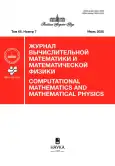BLOCK GENERALIZED METHOD OF MINIMAL INCONSISTENCIES
- Авторлар: Sukmanyuk S.V1, Zheltkov D.A2
-
Мекемелер:
- Lomonosov Moscow State University
- Marchuk Institute of Computational Mathematics RAS
- Шығарылым: Том 65, № 7 (2025)
- Беттер: 1196-1210
- Бөлім: General numerical methods
- URL: https://bakhtiniada.ru/0044-4669/article/view/304084
- DOI: https://doi.org/10.31857/S0044466925070093
- EDN: https://elibrary.ru/JYAXHE
- ID: 304084
Дәйексөз келтіру
Аннотация
Авторлар туралы
S. Sukmanyuk
Lomonosov Moscow State University
Email: s.sukman@yandex.ru
Moscow, Russia
D. Zheltkov
Marchuk Institute of Computational Mathematics RAS
Email: d.zhelikov@innr.ras.ru
Moscow, Russia
Әдебиет тізімі
- Stavtsev S.L., Tyryshnikov E.E. Application of mosaic-skeleton approximations for solving EFIE // Progress in Electromagnetics Research Symposium. 2009. P. 1752–1755.
- Buccini A., Donatelli M., Onisk L., Reichel L. Flexible iterative methods for linear systems of equations with multiple right-hand sides // Numerical Algorithms. 2025. P. 1–29.
- Parlett B.N. A new look at the Lanczos algorithm for solving symmetric systems of linear equations // Linear algebra and its applications. 1980. V. 29. P. 323–346.
- Saad Y. On the Lanczos method for solving symmetric linear systems with several right-hand sides // Mathematics of computation. 1987. V. 48. № 178. P. 651–662.
- Saad Y., Yeung M., Erhel J., Guyonarc'h F. A deflated version of the conjugate gradient algorithm // SIAM Journal on Scientific Computing. V. 21. № 178. P. 1909–1926.
- Simoncini V., Gallopoulos E. An iterative method for nonsymmetric systems with multiple right-hand sides // SIAM Journal on Scientific Computing. 1995. V. 16. № 4. P. 917–933.
- Nachtiqal N.M., Reichel L., Trefethen L.N. A hybrid GMRES algorithm for nonsymmetric linear systems // SIAM Journal on Matrix Analysis and Applications. 1992. V. 13. № 3. P. 796–825.
- Smith C.F. The performance of preconditioned iterative methods in computational electromagnetics. University of Illinois at Urbana-Champaign, 1987.
- Chan T.F., Wan W.L. Analysis of projection methods for solving linear systems with multiple right-hand sides // SIAM Journal on Scientific Computing. 1997. V. 18. № 6. P. 1698–1721.
- Lingen F.J. A Generalised Conjugate Residual method for the solution of non-symmetric systems of equations with multiple right-hand sides // International journal for numerical methods in engineering. 1999. V. 44. № 5. P. 641–656.
- Sukmanyuk S., Zhelikov D., Yaliakhmetov B. Generalized minimal residual method for systems with multiple right-hand sides // arXiv preprint arXiv:2408.05513. 2024.
- Morgan R.B. GMRES with deflated restarting // SIAM Journal on Scientific Computing. 2002. V. 24. № 1. P. 20–37.
- Giraud L., Gratton S., Pinel X., Vasseur X. Flexible GMRES with deflated restarting // SIAM Journal on Scientific Computing. 2010. V. 32. № 4. P. 1858–1878.
- Morgan R.B. A restarted GMRES method augmented with eigenvectors // SIAM Journal on Matrix Analysis and Applications. 1995. V. 16. № 4. P. 1154–1171.
- Morgan R.B. Implicitly restarted GMRES and Arnoldi methods for nonsymmetric systems of equations // SIAM Journal on Matrix Analysis and Applications. 2000. V. 21. № 4. P. 1112-1135.
- Chapman A., Saad Y. Deflated and augmented Krylov subspace techniques // Numerical linear algebra with applications. 1997. V. 4. № 1. P. 43–66.
- Saad Y., Schultz M.H. GMRES: A generalized minimal residual algorithm for solving nonsymmetric linear systems // SIAM Journal on scientific and statistical computing. 1986. V. 7. № 3. P. 856–869.
- Eisenstat S.C., Elman H.C., Schultz M.H. Variational iterative methods for nonsymmetric systems of linear equations // SIAM Journal on Numerical Analysis. 1983. V. 20. № 2. P. 345–357.
- Simoncini V., Gallopoulos E. Convergence properties of block GMRES and matrix polynomials // Linear Algebra and its Applications. 1996. V. 247. P. 97–119.
- Vital B. Etude de quelques méthodes de resolution de problemes lineaires de grande taille sur multiprocesseur. Rennes 1. 1990.
- Cullum J., Willoughby R.A. A survey of Lanczos procedures for very large real ‘symmetric’ eigenvalue problems // Journal of Computational and Applied Mathematics. 1985. V. 12. P. 37–60.
- Cullum J., Zhang T. Two-sided Arnoldi and nonsymmetric Lanczos algorithms // SIAM Journal on Matrix Analysis and Applications. 2002. V. 24. № 2. P. 303–319.
- Robbe M., Sadkane M. Exact and inexact breakdowns in the block GMRES method // Linear algebra and its applications. 2006. V. 419. № 1. P. 265–285.
- Gurknecht M.H. Block Krylov space methods for linear systems with multiple right-hand sides: an introduction // Modern mathematical models, methods and algorithms for real world systems. Anshan, 2007. P. 420–447.
- Arnoldi W.E. The principle of minimized iterations in the solution of the matrix eigenvalue problem // Quarterly of applied mathematics. 1951. V. 9. № 1. P. 17–29.
- Chan T.F. Rank revealing QR factorizations // Linear algebra and its applications. 1987. V. 88. P. 67–82.
- Chandrasekaran S., Ipsen I.C.F. On rank-revealing factorisations // SIAM Journal on Matrix Analysis and Applications. 1994. V. 15. № 2. P. 592–622.
- Bischof C.H., Hansen P.C. Structure-preserving and rank-revealing QR-factorizations // SIAM Journal on Scientific and Statistical Computing. 1991. V. 12. № 6. P. 1332–1350.
- Bischof C.H., Quintana-Ort G. Computing rank-revealing QR factorizations of dense matrices // ACM Transactions on Mathematical Software (TOMS). 1998. V. 24. № 2. P. 226–253.
- Bischof C.H., Hansen P.C. A block algorithm for computing rank-revealing QR factorizations // Numerical Algorithms. 1992. V. 2. № 3. P. 371–391.
Қосымша файлдар









